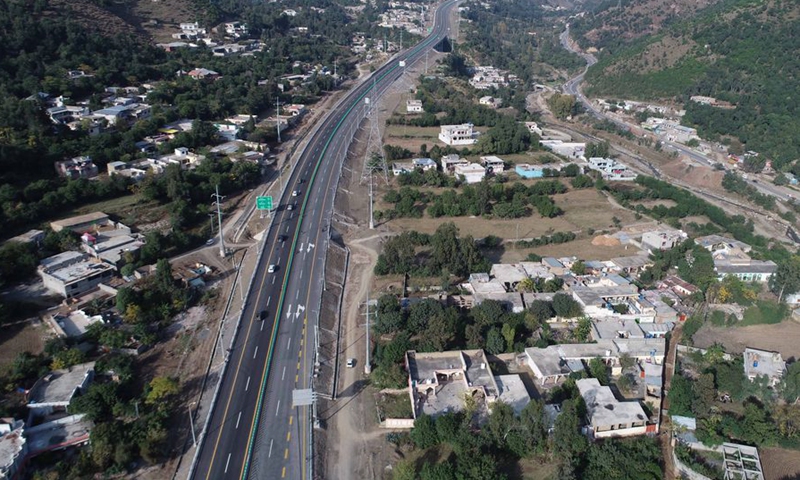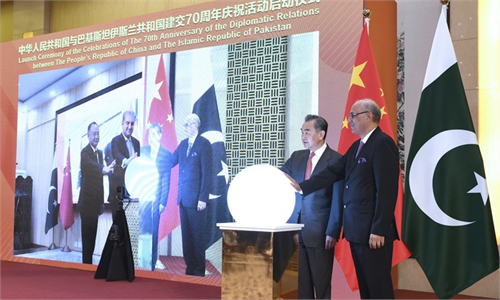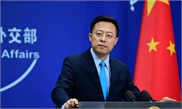
Photo taken on Nov. 18, 2019 shows a view of the expressway section of the Karakorum Highway (KKH) project phase two in Pakistan.Photo:Xinhua
The journey of achieving a modern socialist country is on the right track. This journey aims to develop a shared future for mankind with a result-oriented implementation of consistent five-year plans in a row.
The new Five-Year Plan announced by Premier Li Keqiang at the fourth session of the 13th National People's Congress is the manifestation of China's road of sustainable development that highlights self-innovation and implementation of an innovation-driven strategy.
The path laid in the draft plan for the upcoming years stresses the unity of principle and flexibility that will be the cornerstone in achieving the targets of long-term objectives through to 2035.
The document has focused on economic development, and the emancipation and development of productive forces to concentrate the country's efforts on socialist modernization.
It has regarded socialist modernization and the Chinese dream of a national revival as part of its strategic goals for achieving the unique advantages that will also help the international community to share the fruits of China's development.
The announced plan tells its citizens and international partners alike that China will be maintaining its road of progress that will reflect the development patterns and trends of society for enhancing and deepening multilateral cooperation.
The implementation of the next five-year plan will help facilitate more market access based on market-oriented policies.
Free trade and liberal investment regimes have always been regarded as necessary impetuses for sustainable economic growth that is always advocated by China in global economic governance. It creates a favorable external environment for economic transition and structural reforms in the face of the current anti-globalization tide.
In recent years, the international community has witnessed that the BRI has created a new demand by enhancing effective supply to contribute to rebalancing the world.
Under the 13th Five-Year Plan, we have recorded that the promotion of China's competitive industrial capacity and high-end equipment manufacturing for export are complementary to the industrialization in countries along the BRI.
In the next few years, under the new development plan, the BRI will continue not only to help prove its effectiveness in supply to meet consumer demand but also promote technological progress in less developed countries.
In addition, the 14th Five-Year Plan will also complement the BRI to promote the implementation of the United Nation's agenda for sustainable development in 2030 to rebalance equal development globally.
It means that the international community has several opportunities to cultivate maximum gains by joining hands with China under various platforms based on a win-win situation that is mutually beneficial in various fields.
With the economic transformation and structural advantages, China has emerged as a major player that is releasing its economic growth potential, stimulating market vitality, and stabilizing growth expectations.
The announced GDP target of more than 6 percent for this year shows that China will be seen as playing a more vibrant role in managing economic globalization and strengthening global growth.
The splendid performance of the Chinese economy during the ravaging COVID-19 period in 2020 has already shown its resilience that's helped various countries to revive their economic structures. China's internal and external development environments have already seen profound changes for the Chinese and the global community at large.
China's previous economic output shows that sustainable economic development will be achieved in the years to come that will also have a positive global impact.
The country's long-term objectives through 2035 generate the message to the world that China is a promising partner for bilateral and multilateral arrangements in the coming decades.
The objectives through 2035 impress the world that Chinese leadership will be following sustainable progress and development plans with absolute consistency.
China's economic development pattern of "dual circulation," with the motive to reinforce domestic and overseas markets based on a solid foundation has enabled the Chinese system to pursue the fulfillment of local and global needs.
The path presented in the draft is also the manifestation that China will continue offering support for globalization and multilateralism for the integration of China's road of development with the world.
The country's journey of development will be pushed forward not simply as a stakeholder but as a responsible major player in the international governance system.
The author is a journalist with Independent News Pakistan and media fellow of China South Asia and South East Asia Press Centre 2017


